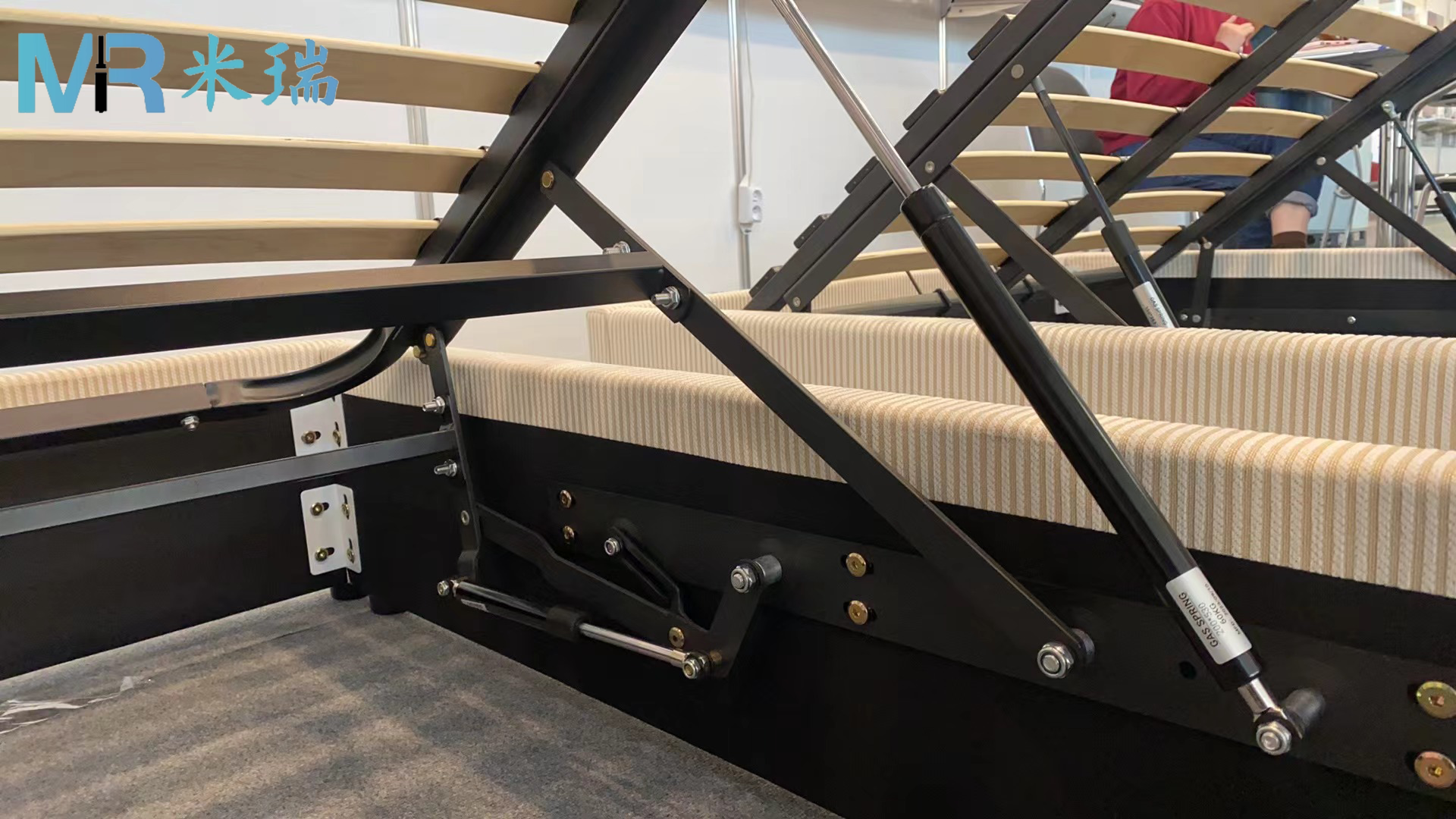close
Choose Your Site
Global
Social Media
Author: Site Editor Publish Time: 2025-09-18 Origin: Site
Springs are an essential part of numerous mechanical systems, serving as energy storage devices that help store and release energy when needed. Whether you realize it or not, springs are involved in many aspects of our daily lives, from car suspension systems to office chairs. While most people are familiar with mechanical (normal) springs, there is another type known as gas springs that is gaining popularity in a variety of applications. In this article, we will explore the key differences between gas springs and normal springs, covering everything from how they work, their advantages and disadvantages, to their ideal applications.
A spring is a mechanical component designed to store and release energy. Springs work by deforming under an external force and returning to their original shape once the force is removed. They play a vital role in mechanical systems, helping absorb shock, store energy, and even control motion.
There are several types of springs, including:
Helical Springs: Wound in a coil shape, used in suspension systems and various other mechanical systems.
Leaf Springs: Made of layers of metal, often used in the suspension systems of trucks.
Torsion Springs: Twisted to store rotational energy, used in things like clothespins or garage doors.
Each of these springs operates on the basic principle of deformation and recovery, but the manner in which they store energy and their applications can vary significantly.
Springs are crucial to many systems because they can store potential energy. When external forces act on a spring, it deforms (either by compressing or stretching), and when those forces are removed, the spring returns to its original shape. This ability to store and release energy makes them indispensable in applications where controlled force or motion is required. Springs are used in diverse fields including automotive systems, industrial machinery, medical devices, and consumer products.

Normal springs are mechanical springs, which store energy through deformation. When a force is applied, the spring deforms (either stretching, compressing, or twisting), and when the force is removed, the spring returns to its original shape. Mechanical springs are typically made from high-strength materials like steel or other alloys.
There are several types of normal springs:
Helical Springs: These are the most common type, wound in a coil shape. They can be used for both compression and tension.
Leaf Springs: Used in the suspension systems of vehicles, these springs consist of multiple layers of metal that flex to absorb shock.
Torsion Springs: These springs store rotational energy, often used in applications like garage doors and clothespins.
Normal springs are incredibly versatile and can be found in numerous applications:
Automotive: Springs are used in suspension systems to absorb shocks and maintain vehicle stability.
Industrial Machinery: Springs are used in machines to provide force or cushioning.
Household Items: Springs can be found in items like pens, mattresses, and door hinges.
These applications rely on the inherent ability of mechanical springs to store and release energy under varying conditions.

A gas spring (also known as a gas piston or gas strut) is a type of spring that uses compressed gas—typically nitrogen—to store and release energy. Unlike mechanical springs, gas springs do not rely on a material's elasticity to create force. Instead, they use the pressure of gas inside a cylinder to generate force. Gas springs are designed with a gas-filled cylinder, a piston rod, a piston, a sealing guide sleeve, and an inert gas or oil-air mixture.
Gas springs operate by compressing the gas inside a cylinder, which creates pressure that pushes the piston and extends the spring. This pressure generates a lifting or supporting force. There are two main types of gas springs:
Compression Gas Springs: These springs generate force by compressing the gas, which pushes the piston and extends the spring.
Tension Gas Springs: These springs work by pulling the piston, generating a force that allows for controlled movement in one direction.
Adjustable Force: Unlike normal springs, the force exerted by a gas spring can be adjusted based on the requirements of the application. This makes them ideal for applications requiring precise force control.
Smooth and Controlled Motion: Gas springs provide smooth motion, ideal for uses where precise control is necessary.
Minimal Noise: Gas springs operate with minimal noise and vibration, making them ideal for environments where noise reduction is a priority.
No Need for Pre-Load: Gas springs provide a full load upon contact, eliminating the need for pre-loading, which is common with normal springs.
Gas springs have a wide range of applications across various industries:
Automotive: Used in car hoods, trunks, and lift gates to provide smooth opening and closing.
Medical: Commonly found in hospital beds and adjustable chairs where height and angle adjustment are necessary.
Industrial: Used in machinery safety covers and other devices requiring controlled lifting and lowering.

The fundamental difference between a gas spring and a normal spring lies in how they store and release energy. Normal springs store energy through mechanical deformation, whether it’s compression, tension, or torsion. Gas springs, on the other hand, store energy using compressed gas, typically nitrogen. This difference leads to significant variations in their performance and applications.
Gas springs offer the ability to adjust the force they provide, making them more versatile for specific applications. Normal springs do not offer this adjustability; instead, their force depends on their size and material, and changing the force often requires switching to a different spring size or type.
Gas springs are typically smaller and more compact than normal springs, which makes them ideal for applications where space is limited. This compactness is one of the primary reasons gas springs are used in automotive and medical applications.
Gas springs are more expensive than normal springs due to the specialized manufacturing process and materials used, such as gas cylinders and seals. However, their longer lifecycle and reduced maintenance requirements often justify the higher upfront cost. Mechanical springs, on the other hand, tend to be more cost-effective but may wear out faster, requiring more frequent maintenance or replacement.
Gas springs are sensitive to changes in temperature and pressure. Extreme temperatures can affect the performance of the gas spring, potentially leading to a reduction in force or failure. Normal springs are generally more resilient to temperature changes and can perform well under a wide range of environmental conditions.
Gas springs are designed to operate quietly and with minimal vibration, which is a significant advantage in applications where noise and vibration need to be minimized. Normal springs, especially those in high-frequency applications, can produce noise and vibration.
Gas springs provide a more compact and adjustable solution compared to normal springs. Their ability to adjust the force makes them suitable for applications requiring precise control over the lifting, lowering, or positioning of objects.
The primary advantage of gas springs is their ability to offer smooth, controlled motion, which is essential in applications like automotive lift gates or medical beds. Gas springs provide precise force and damping control, which normal springs cannot offer.
Due to the sealed gas chamber and minimal mechanical components, gas springs tend to have a longer lifecycle and require less maintenance than normal springs. This makes them a more reliable option in the long term, especially in applications with frequent use.
One of the major drawbacks of gas springs is their higher initial cost. The specialized manufacturing process, gas seals, and materials contribute to their cost. For budget-conscious applications, normal springs might be a more cost-effective solution.
Gas springs can be sensitive to changes in temperature and pressure, which may require additional maintenance or temperature control in certain environments. Normal springs are generally more tolerant to environmental changes.
When selecting the right spring for your application, several factors must be considered:
Load Capacity: Gas springs are often ideal for lighter loads, while normal springs can handle heavier loads due to their material strength.
Size and Space: If space is limited, a gas spring may be the better option due to its compact design.
Cost: Gas springs tend to be more expensive initially but offer better long-term value with fewer maintenance requirements.
Performance: If precise motion control and adjustability are required, gas springs are the ideal choice.
Operating Environment: Consider the temperature and pressure conditions in which the spring will operate. Normal springs are more resilient to environmental extremes.

A gas spring stores energy using compressed gas to provide constant force over a long distance, ideal for applications requiring smooth movement and force adjustment.
In many cases, yes, gas springs offer more versatility and smoother motion. However, cost and environmental conditions need to be considered.
Yes, gas springs typically have a longer lifecycle and require less maintenance due to their sealed design and fewer moving parts.
Gas springs are commonly used in automotive, medical, and industrial applications where controlled motion, lifting, and adjusting force are required.
Gas springs are made with more specialized materials and manufacturing processes, contributing to their higher initial cost. However, their longer lifecycle and reduced maintenance needs justify the cost.
Mechanical springs generally have a higher load capacity due to their material strength, while gas springs are typically used for lighter loads requiring precision control.
Mechanical springs are more durable and can handle a broader range of temperatures and conditions, but gas springs have a longer lifecycle with less wear and tear.
Gas springs are ideal for applications requiring precise control, such as automotive lift gates or adjustable hospital beds.
Normal springs, particularly helical and torsion springs, are better suited for applications requiring rapid acceleration and deceleration, like in aerospace or automotive suspension systems.
Understanding the differences between gas springs and normal springs is essential when choosing the right spring for a specific application. Gas springs offer advantages in terms of precision, adjustability, and smooth motion, while normal springs tend to be more cost-effective and resilient in harsh conditions. By carefully considering your needs, such as load capacity, space, cost, and performance, you can select the most suitable spring for your application, ensuring optimal performance and reliability.